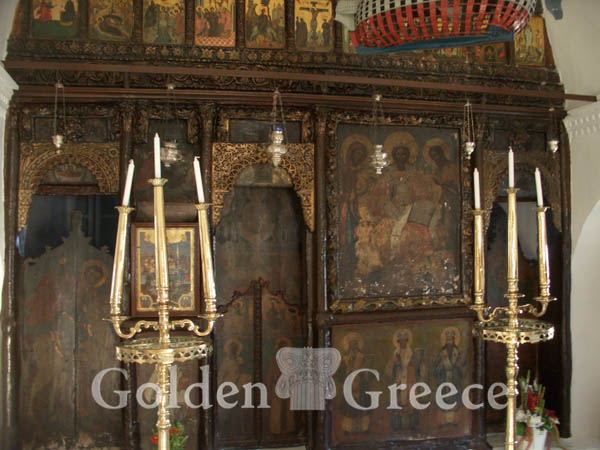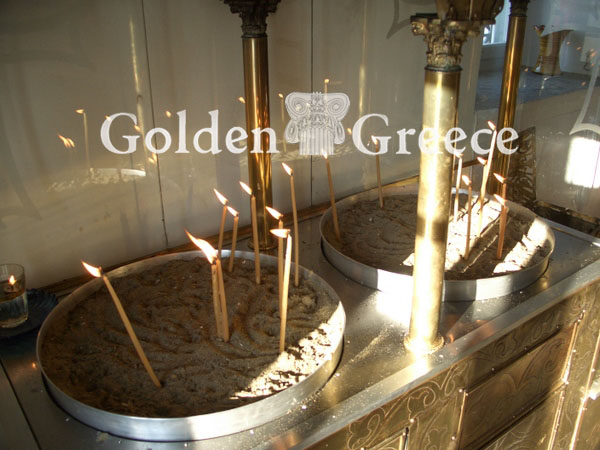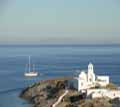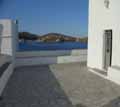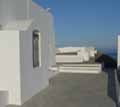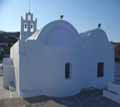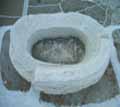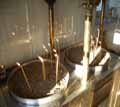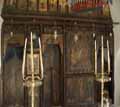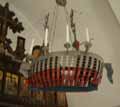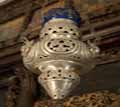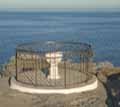
The dissolved women's Monastery of Panagia Chrysopigi is built on a rock, on the cape of Faros bay. The name Chrysopigi is related to the Monastery of Chrysopigi in Chania, where the Cretan monk Parthenios Hairetis lived as a monk before coming to Sifnos. He recorded in 1677 the miracles of Panagia and gave her the name Chrysopigi. One of the most famous miracles is the saving of the island from the plague epidemic on the day of the Ascension of the Lord in the year 1676. In 1964, Panagia Chrysopigi was officially declared the patroness of Sifnos. The first church, called Panagia to Komma (because of the cut rock where it was located), was built in 1650 by Nikolaos Pitzini on the ruins of an older church. In 1675, it was demolished and a larger church was rebuilt by the priest Hieronymos Zambelis-Rousso. In 1760 it was sold by the heirs of the priest to the Monastery of Vrysiani, to which it belongs as Metohi until today. The church is a vaulted basilica with a semicircular arch. Inside, you can see the wood-carved iconostasis, partially gilded, and the miraculous icon of Panagia Chrysopigi is kept. An inscription "year 1818" is preserved on the marble floor. The monastic complex includes a marble spring (behind the temple), guesthouses for visitors and 2 cells, which were used by the poet Aristomenes Proveleggios and the rhymer Antonios Dekavallas. The church celebrates with a great festival and procession of the icon of the Virgin Mary on the day of the Ascension of the Lord, 40 days after the Resurrection. Inside, you can see the wood-carved iconostasis, partially gilded, and the miraculous icon of Panagia Chrysopigi is kept. An inscription "year 1818" is preserved on the marble floor. The monastic complex includes a marble spring (behind the temple), guesthouses for visitors and 2 cells, which were used by the poet Aristomenes Proveleggios and the rhymer Antonios Dekavallas. The church celebrates with a great festival and procession of the icon of the Virgin Mary on the day of the Ascension of the Lord, 40 days after the Resurrection. Inside, you can see the wood-carved iconostasis, partially gilded, and the miraculous icon of Panagia Chrysopigi is kept. An inscription "year 1818" is preserved on the marble floor. The monastic complex includes a marble spring (behind the temple), guesthouses for visitors and 2 cells, which were used by the poet Aristomenes Proveleggios and the rhymer Antonios Dekavallas. The church celebrates with a great festival and procession of the icon of the Virgin Mary on the day of the Ascension of the Lord, 40 days after the Resurrection. used by the poet Aristomenes Proveleggios and the rhymer Antonios Decavallas. The church celebrates with a great festival and procession of the icon of the Virgin Mary on the day of the Ascension of the Lord, 40 days after the Resurrection. used by the poet Aristomenes Proveleggios and the rhymer Antonios Decavallas. The church celebrates with a great festival and procession of the icon of the Virgin Mary on the day of the Ascension of the Lord, 40 days after the Resurrection.
Editor: Niki Kalopaidis






